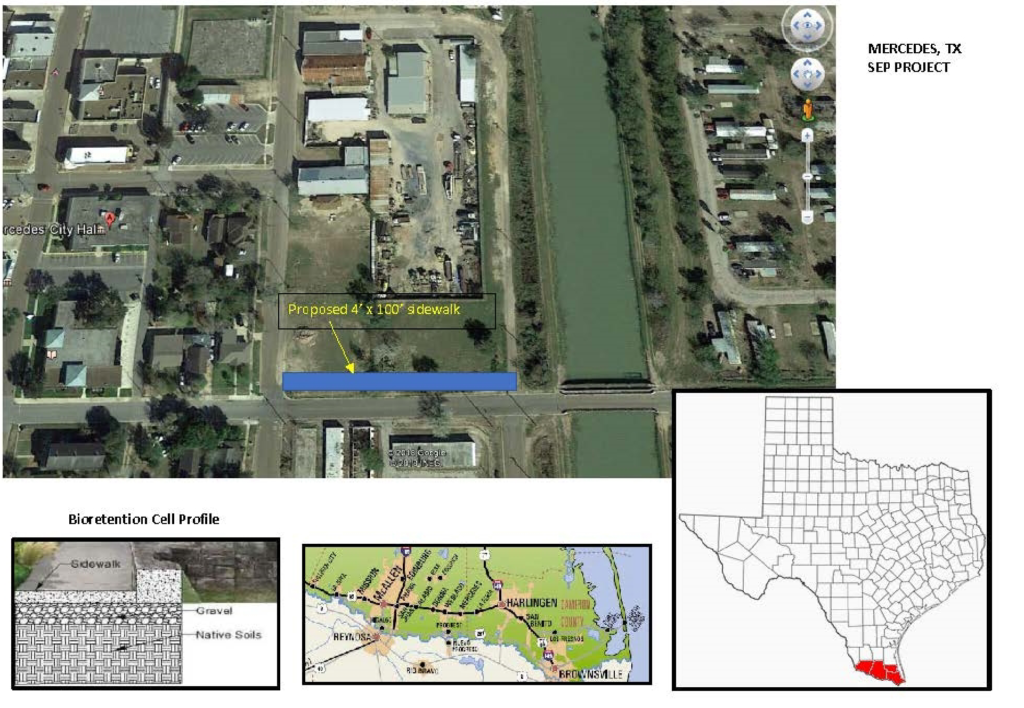The GI Master Plan will provide a unique innovative strategy that will be used as a demonstration tool that can be duplicated throughout the region. The main objectives of the GI Master Plan that the City wants to implement are to 1) minimize the environmental impact of the rainwater, 2) avoid localized flooding, 3) stop the contamination of the water and 4) integrate it to the construction projects through the development of natural drainages. Through the GI Master Plan, the City intends to establish the general and specific guidelines for the management and treatment of rainwater to diminish its impact and to apply the strategies that allow for the construction of “green” structures. Of the twenty-one (21) LRGV Stormwater Task Force members, solely the City of Weslaco has GI language in its drainage policy, primarily stating that GI strategies can be used in managing stormwater runoff. Through this project, the City of Mercedes and other participating local governments will assess GI facilities, and will consider providing language that encourages GI in their policies. The GI Master Plan is an approach for land development that works with nature to manage rainwater and it’s based in the preservation and recreation of natural landscape characteristics, minimizing impervious surfaces to create a functional drainage. The idea is that rainwater can be integrated as a natural attraction of urbanism instead of being considered a discarded product, therefore avoiding the creation of ponds and future contamination.
The GI Master Plan will benefit the public and the environment by providing innovative and emerging information to the region in order to meet the challenging requirements of water quality, flooding and public safety. Improving water quality, reducing localized flooding, and identifying sustainable, economical and innovative stormwater management strategies is a key benefit that will result from the development of the GI Master Plan. Although this project will be implemented in the City of Mercedes, UTRGV is partnering with the LRGV TPDES Stormwater Task Force (STF) and the Coastal Cities Task Force (CTF) in the promotion of the GI Master Plan to the region. The coalitions are comprised of 33 local governments, a population of over 750,000. The institutionalization of GI infrastructure strategies, the introduction of low impact development programs, and the implementation of innovative planning, management and engineering approaches to water programs will not only benefit communities, but the environment. The successful institutionalization of innovative stormwater management programs will reduce NPS pollutants, mitigate localized flooding in urban, colonia, and rural settings, and improve water quality BMPs utilized by residential, commercial and industrial stakeholders. The improvement of water quality within the surface waters of the region is a significant benefit to the environment.
The City will contract with UTRGV in developing this project and assuring a regional buy in from local communities and stakeholders. UTRGV will provide facilitation, and project reporting directly with the border 2020 project manager.
Objectives
The proposed GI Master Plan project meets the requirements of Goal 2 under the Objective 2, Type 2 project classification. Goal 2 is fulfilled by the project content which will include educational and research topics associated with stormwater management. Goal 2 is further fulfilled by the educational outreach activities that will be required by the project in order to promote the GI stormwater runoff management strategies to local school districts officials, colonias, institutes of higher education, city and county officials, water professionals, professional organizations and water-related organizations. The goals of the GI Master Plan are as follows:
- Provide an understanding of drainage concepts and patterns in the community;
- Describe properties and tendencies of the major watersheds in the region;
- Explain precipitation patterns and the concept of percentiles, zero runoff approaches, and the importance of water quality;
- Explain detention and promote alternatives to conventional design;
- Engage residential, commercial and educational stakeholders;
- Promote topics that will educate residential, commercial and educational stakeholders;
- Change the mind set of water professionals by promoting a new engineering paradigm
Contact Info

Background Information
The City of Mercedes (City) in partnership with the Lower Rio Grande Valley (LRGV) and The University of Texas Rio Grande Valley (UTRGV) proposes to develop a demonstration green infrastructure (GI) master plan to mitigate localized flooding in a high priority region within the city limits of the City. Local governments in the LRGV control localized flooding and stormwater runoff by adopting strict drainage design policies. During the course of this project, participating local governments and the project team will review drainage policies. The project team will identify those that already incorporate GI language, will provide GI related information to the local government staffers and will provide recommendations for policy enhancement. The flat terrain characteristic of the LRGV provides stormwater engineers with complicated flow, detention and flood design problems.
Outreach Activities
| Event | Date | Presentation |
| Lower Rio Grande Valley 21st Annual Water Quality Management and Planning Conference | May 19-25, 2019 |
| 2019 EPA Region 6 Stormwater Conference | July 28-August 1, 2019 |
Agenda |
| Final Workshop | January 30, 2020 | Powerpoint Presentation |
Resources
Priority locations in the City of Mercedes
Funding
This funding technical assistance agreement TAA18-007 is provided by the Northern American Development Bank and the Border Environmental Cooperation Commission.

